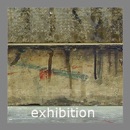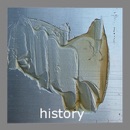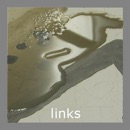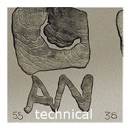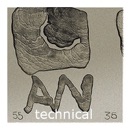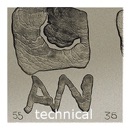
CHARACTERISTICS OF LITHOGRAPHY
Most lithographic drawing materials are composed of some form of grease, tallow, beeswax, shellac, soap and lamp black. They include lithographic crayons or chalks, pencils, rubbing crayon, and liquid drawing ink known as tusche. Each material has its own unique and expressive quality and may be used to develop a broad range of mark making not possible in other graphic media.
Lithographic crayons and pencils range from hard copal crayons that have little grease content, to soft and greasy ones that produce rich smudgy drawing. All manner of crayons can be used for drawing and in any combination with other materials, worked usually fat over lean to produce images of varying character. Blades and hones can also be used to scratch and scrape through crayon drawing – to lighten and delete areas or to create engraved lines seen as white against black. Rubbing crayon – which is often used with gum stop out, is effective for achieving soft smudgy atmospheric effects similar to that found in charcoal drawing.
Liquid drawing ink known as tusche is favoured by many lithographers since as it dries, pigment settles out as it reticulates on the surface of the stone, to create an exaggerated web-like texture – that is quite unique and distinctive to lithography. Some lithographers are keen to exploit this reticulation, such that the quality of the drawing material itself becomes an intrinsic part of the creative development of the image. Applied on to zinc or aluminium plate, the same tusche can reticulate in quite different ways to form a texture that is sometimes referred to as Peau de Crapaud or toad-skin. Curiously tusche can also be mixed with a variety of different solvents, including distilled water, turpentine and surgical spirit –each causing subtle differences in reticulation and in the final appearance of the wash when it is printed.
Gum Arabic, which is much used in the processing of stones and plates because of its desensitising property, can also be used as a masking agent – like masking fluid in watercolour painting. Diluted with water, gum washes, also known as Lo-Shu Washes allow for negative or white line drawing seen against a dark back-ground. Further processes of working in negative include manière noir, where the image is developed using hones, pumice pencils and blades to lighten areas of an ink-ground first prepared on the stone. By applying varying pressure, the image can thus emerge from the black background much in the same way that images are produced in mezzotint. Similarly in acid tint, drawing is achieved with the application of nitric acid, which quite literally burns into the ground to produce a range of tone similar to that seen in aquatint.
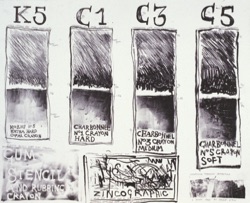
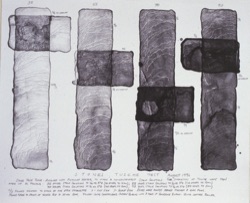
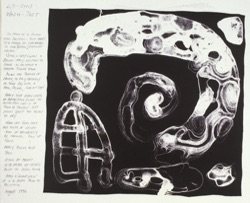
Crayon Tests showing Korns Copal Crayons, three grades of Charbonnel Crayon, rubbing crayon and zincographic ink.
Tusche Wash Tests using four concentrations of Stones Paste Tusche
Lo-Shu Wash Test
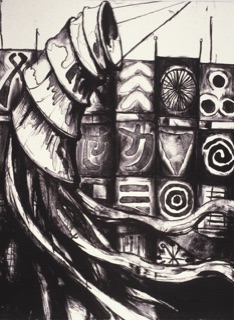
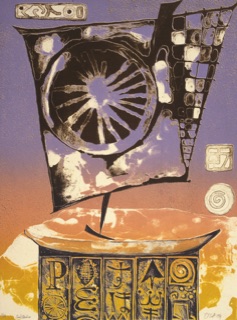
Wind Chime Shrine 1994
Crayon and Tusche
Sail Shrine 1994
Lo-Shu Wash, crayon drawing and negative photoplate
All lithographic materials are either black or brown – so this requires images to be conceived and developed tonally. It is also important that the artist is able to draw a stone or plate that is to print, say yellow – as strongly as if it were to print in black. Once the image has been processed – the same drawing can obviously be inked in whatever colour is preferred and since most colour inks are transparent, it is then possible to achieve secondary colours through overprinting of crayon and tusche, layering colours printed from series of plates and stones.
Whilst some artists prefer to print only from stone, it is common nowadays for most colour printing to be achieved using either aluminium or zinc plates. These are plates that are specially manufactured, ball-grained with a surface that closely resembles that of stone. Being uniform in structure, lighter than stone and potentially large in scale, plates are ideal for experimenting with colour combinations, enabling changes in order and changes of colour during proofing. Often plates are printed in combination with stones, which commonly are used to print the final key image in black to help resolve the finished print.
Popular with many artists too are the photoplates that are still used in commercial printing for offset lithography. These plates are manufactured with light sensitive emulsion and are designed principally for industrial use for the printing of both text and images on a massive scale. Photoplates allow for a whole range of possibilities and an expansion beyond the purely autographic. Photoplates may be exposed with a wealth of material, including photographic and computer generated digital images, photocopies, as well as drawings that will have been prepared on translucent or transparent materials such as acetate, tracing paper or True Grain Film.
In Japan during the 1980s research into the new process of waterless lithography led to the development of a specialised type of photoplate called Toray Plate. This process, also known as siligraphy became important since it negated the need for water to be present during printing – and thus eliminated potential problems of tinting, paper stretch and misregistration. In its place Toray Plates rely upon a silicone coating that remains in the negative areas after an image has been exposed and developed and it is this that repels the ink during printing. Intended for printing at high speed on automated presses, Toray Plates can be used for hand lithography providing that appropriate inks designed specifically for waterless lithography are used. One of the advantages of this process is the considerable detail and subtlety of mark that can be achieved.
Canadian artist Nik Semenoff at The University of Saskatchewan has been a leading researcher in waterless lithography; using thinned down silicone caulking he has developed techniques that allow drawings made on conventional ball-grained plates to be processed for waterless printing. Highly inventive in his approach, Semenoff has been responsible for a whole catalogue of techniques including the use of toner as a substitute for tusche, the development of toner chalks, toner transfers, gum transfers, reversals and the formulation of his own photo-sensitive emulsion. His ingenuity has also stretched to the invention of Tri-Partite Rollers for waterless lithography, Palm Presses and a method for offset printing using a direct press.
That the principle of lithography could be inverted, such that water-based drawings materials are used instead of greasy ones – was actually mooted by Senefelder in 1798 and in the future this could lead to the development of wholly non-toxic techniques of printmaking. By substituting grease-based materials for water soluble ones including pencils, crayons and washes composed of tempera powder, for a brief period at the turn of the millennium, it was also possible to print plates using water based inks, but unfortunately these are currently unavailable.
Waterless lithography has also been developed in conjunction with the use of Polyester Plates marketed in the US as Pronto Plates and in the UK as Omega-EZ Plates. These plates have been designed principally for desk-top publishing allowing images and text designed on the computer to be printed quickly using relatively small presses. Not unlike the earlier Paper Plates that were in common use during 1960s, these plates are useful for printing digital images either conventionally or as waterless lithographs.
It is clear then that lithography is a highly versatile medium allowing for an extraordinary range of printing to occur, from the most delicate of marks that merely kiss the surface of the paper to flats of colour that appear bright and bold. I like many other artists have always been impressed by the directness of lithography and the fact that what ever is drawn on the surface of a plate or a stone, each and every mark will in effect be printed on to the surface of the paper.
